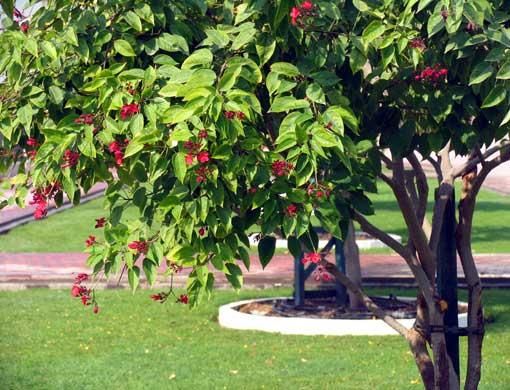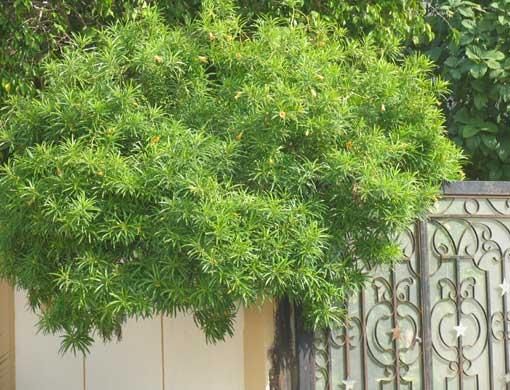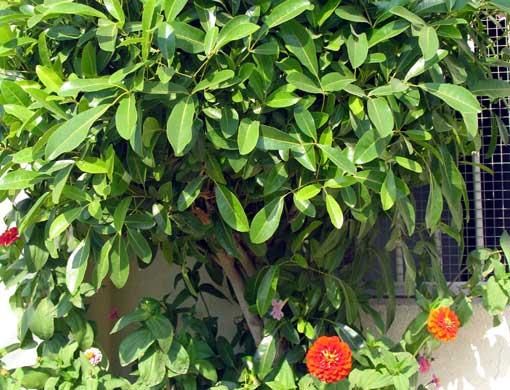Shrubs are an indispensable part of any well-designed landscape. Along with trees, shrubs form the backbone of a garden, giving it permanence, shelter, shade, privacy and year-round colour.
Taller than herbaceous plants and shorter than trees, shrubs play an important role in tying together elements of varying heights in the landscape. The gap between the tall trees and low-growing grass and groundcovers can look rather abrupt, but a selection of shrubs of intermediate heights will fill this gap.
Attractive yet functional
Many ornamental shrubs can be enjoyed for the beauty of their flower, foliage or fruits, but their role extends beyond providing decorative greenery in your yard. From attracting birds to creating screens for privacy, shrubs have many practical uses that make your garden striking as well as functional. The best thing about shrubs is they are small enough to be planted in areas where trees will not fit, yet large enough to add texture, form and height to a landscape. Shrubs can be effectively used to fill spaces and define areas around your yard. Taller shrubs can be planted behind flowering beds as a solid backdrop or foundation.
Attractive flowering shrubs with long term interest can be used as single specimen to provide appealing focal points. For instance, ornamental shrubs such as jatropha, ixora and hibiscus with bright red showy blooms can be inter-planted with white grasses such as pennisetum or flowering annuals for creating eye-catching accents around the paved area, or in the corner of the lawn, where the blossoming shrub can be viewed from all sides. Another appropriate place for planting a solitary shrub as a primary focal point is near the front door, where it will stand out and direct attention to the entrance.
In bigger yards, several shrubs can be planted in groups or in rows for a more dramatic effect. You can plant the shrubs of the same type together for a unified effect or select a combination of shrubs to create colourful contrasts.
Shrubs can be used to frame pathways, or to create mixed borders, when planted with groundcovers. A mixed shrub border is a clever way of combining different plants with different seasonal displays. Many medium-sized shrubs make great companions to herbaceous annuals and perennials, providing cool shade for their growth when the sun gets too hot.
Privacy
Shrubs are also used as hedges or for screening unsightly features in your garden. Even if your garden already has a fence or a compound wall for privacy, planting a row of shrubs will soften the harsh lines of the fence. Many shrubs such as peacock flower, yellow oleander, etc., make excellent informal hedges.
A strikingly handsome shrub commonly used for enhancing the landscape is the peacock flower (Caesalpinia pulcherrima). This attractive shrub with its profusion of bright orange showy flowers is extensively planted in commercial and residential properties in the UAE as a screen, hedge or accent plant.
Selecting the shrubs
When carefully selected, an area planted with shrubs has a much lower maintenance demands than a similar area of lawn.
The key to successful gardening is to understand the growing conditions of your yard and select plants accordingly. While a shrub may look very attractive in a public park or a nursery, it will not look anywhere near as stunning in your garden if the soil, light and water conditions of your yard do not meet the plant's cultural requirements.
Fortunately, there are many hardy shrubs that will grow well in full sun and well-drained soil. However, a few picky species may be more fastidious in their demands and will not thrive unless these requirements are met. A case in point is the flowering shrub ixora, which requires acidic soil for healthy growth.
When grown in alkaline soil, ixora is extremely prone to iron and manganese deficiencies and suffers from a condition called chlorosis, where its glossy dark green foliage start turning yellow. A continued micronutrient fertility treatment is needed to correct the deficiency. Liquid micronutrients sprayed on the foliage according to the manufacturers' recommendations will work best for treating this problem.
In general, acid-loving species such as ixora, allamanda, hibiscus, etc., should not be planted next to sidewalks and concrete foundation, where the soil is alkaline and high in calcium.
Initial preparation of the ground is more important than any after-care you will later provide. Poor soil, damaged roots and wrong choice of the site can never be remedied later.
Therefore, it is vitally important that you prepare the site well by digging out the rubble and sandy soil and filling this hole with well-rotted manure or compost, and applying a final layer of sweet topsoil, so the roots do not touch the manure. Water polymers may be added to the topsoil to further help it retain moisture.
Most plants require maximum water immediately after being planted and during establishment. Newly planted shrubs and trees are especially prone to drought damage and that is why care must be taken to irrigate them properly.
According to Kasali Mohammad, managing director, Black Rose Landscaping, Dubai, drip irrigation is the best way to water plants in our kind of climate, where water is a rare commodity and proper water management is essential to promote a healthy landscape.
"Drip irrigation uses much less water than sprinkler irrigation since it carries water more effectively into the root zones of trees and shrubs. Spray system popular in Europe will scorch leaves in our climate because of the salt residue. Applying mulch to the surface will further cut down surface evaporation and save at least 20-30 per cent water," recommends Mohammad.
There is a whole range of shrub varieties available at local nurseries and garden centres. However, it is important to keep in mind that a few judiciously selected shrubs placed at appropriate sites will produce a far more pleasing effect than an ill-planned jumble of haphazardly planted shrubs.
Your garden, after all, is a place where you can relax; therefore your emphasis while planting shrubs should be on creating a simple, manageable landscape with balance, rhythm and harmony. A well-designed restrained palette will not only be easy to maintain, but will also be more visually appealing.
Mulch, prune, water, wrap
It is important to provide good after-care to the newly planted shrubs in your yard. Good gardening practices include regular mulching, pruning, watering, wrapping, staking and fertilisation.
Allow enough space (a minimum of 1metre) between the shrubs to accommodate the mature size of the plant, otherwise, in a few years' time, the area will appear overcrowded and overgrown.
Plant with your children and pets in mind. Some popular ornamental shrubs with low-water requirements such as yellow oleander (Thevetia peruviana) or oleander (Nerium) are toxic bushes that exude a highly poisonous milky sap. Therefore, you must avoid planting them in children's play areas.
Avoid planting thorny shrubs near the entrance and children's play area.
Avoid planting acid-loving shrubs such as ixora, hibiscus, allamanda, etc., near concrete walls where the high levels of calcium makes the soil alkaline and therefore unsuitable for their healthy growth. Do not use pea rock as mulch for acid-loving shrubs.
For a more natural look, plant shrubs in odd numbered groups of threes or fives.
Do not plant tall shrubs in front of the windows, for they will not only block the outside view, but will also prevent sunlight from entering your room.
While pruning a shrub, keep it slightly wider at the base and narrower at the top to enable sunlight to reach the lower branches.
Varieties: Look at the hardy ones
Never select a shrub simply because you happen to like the colour of its flowers. Shrubs in your garden are long-term investments and you must consider their final height, width, foliage colour, texture and fruiting habits before you allot a place for them in your yard. Kasali Mohammad, managing director, Black Rose Landscaping, Dubai, recommends the following hardy shrubs that do well in the UAE climate:
Atriplex semibaccata (Australian saltbush): Atriplex is a drought-tolerant, low-growing shrub with silvery gray evergreen foliage.
Adenium obesum (Desert Rose): A succulent bush with fleshy leaves and beautiful pink trumpet shaped flowers, Adenum is a drought-tolerant species that thrives in full sun.
Caesalpinia pulcherrima (Peacock Flower or Dwarf Poinciana): A popular evergreen shrub with masses of brilliant scarlet, orange and yellow showy flowers, this shrub grows in part shade to full sun to provide year-round colour in your garden.
Dodonaea viscose (Sticky Hopbush): This drought resistant fast growing shrub can be grown as a clipped hedge or an informal screen.
Hibiscus rosa sinensis (China rose or shoe-flower): A spectacular flowering shrub producing showy blossoms in shades of red or yellow throughout the year, hibiscus is excellent as a specimen or accent plant.
Ixora coccinea: An evergreen shrub bearing globular clusters of brilliant orange-red, flowers, ixora makes an attractive accent or hedge plant that attracts a lot of birds. However, being acid-loving, it is prone to chlorosis when grown in alkaline soil.
Jatropha (Coral plant): A dependable bloomer, this evergreen shrub bearing attractive scarlet flowers is a must in your yard if you wish to invite butterflies and birds.
Lagerstroemia indica. (Crepe Myrtle or Queen's Flower): An attractive drought-tolerant shrub with pink, mauve or purple blossoms, Crepe Myrtle is so named because of its crinkled petals.
Malvaviscus arboreus (Sleepy Mallow or Turk's Cap): Getting its unusual name from the petals which never open fully, Sleepy Mallow with its bright red sleepy blossoms attracts nectar-sipping sunbirds.
Nerium oleander (Oleander): This fairly large shrub bearing pink, white or red blooms makes a popular screening shrub. However, all parts of the shrub are poisonous.
Thevetia peruviana (Yellow Oleander): A bushy shrub bearing lemon yellow flowers. Every part of this large shrub is poisonous and should be kept out of reach of children and animals.
Vitex agnus castus (Chaste tree): An attractive shrub bearing pink, purple or white flowers, this drought-tolerant species can be grown as a border or specimen shrub.
Perfect for privacy
If your garden has a compound wall for privacy, planting a row of shrubs helps soften the harsh lines of the fence.













